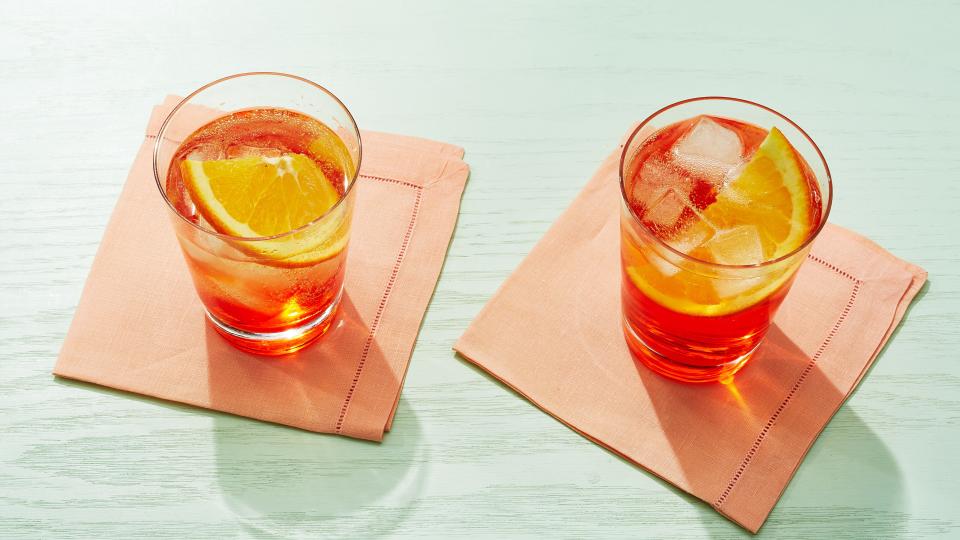The Spritz Is Truly the Drink of Summer—Here's Why
While rosé will always have its place as a summer drink, the spritz has been giving pink wine a run for its money in recent years. The most well known version in the U.S. is the Aperol Spritz, but there are actually dozens of variations, and many trace their roots much farther back than the Aperol one. To get some spritz perspective, we spoke to sommelier Jordan Salcito, the creator of the uber-lovely and refreshing Ramona, one of the first canned wine spritzes on the market when it launched in back in 2016.
Salcito shared that spritzes can be traced as far back as the ancient Romans and Greeks. "Basically, it was considered very uncouth to be drunk at any meal, and the only one who was allowed to drink undiluted wine was Dionysus, the god of wine," she explains. "So it was quite common to add water, or even sea water to wine, and then there were various iterations of that involving adding honey, berries, and flowers." In slightly more modern times, the origin of the spritz is goes back to Northern Italy, when Austrians occupied the land under the Hapsburg Empire. Supposedly, they didn't like the taste of the wine there, so they began adding a "spritz" (German for spray) of water to make them more palatable, says Salcito. Today, all spritzes have bubbles, which happened in the early 20th century, as the drink continued to evolve.

Bryan Gardner
"And then, the Italian futurist art movement—which was basically a rejection of the past and an embrace of technology and youth—gave way to the futurist cocktail movement," says Salcito. "It was about using new ingredients and having new flavors and doing things in a new way." Two of these new ingredients were Aperol ($28.99, wine.com) and Select (From $28.59, drizly.com), which joined Campari ($34.99, wine.com), and they were all bright red or orange bitter liqueurs that really made a statement. "It was eye-catching and well-marketed with the cool new advertisements that came along with the Futurist movement," says Salcito. Italians latched onto it, and the newest iteration of the Italian spritz was born, consisting of white wine, soda water, and a bitter liqueur.
Related: Summer Cocktails You'll Want to Make All Season Long
Why bitter? Salcito thinks it comes from Italians' love of food. "There's always a subtext with anything Italian, because so much about Italy has always been about food, dining, and drinking," she says. "The spritz is the perfect aperitivo because it is bitter, so it opens up one's taste buds and is the perfect entry to a meal." And while Aperol existed, it wasn't nearly as popular as it is today. That happened in the 1990s, when the company went on an aggressive marketing campaign in certain parts of Northern Italy, around the time prosecco was added to the formula.
As prosecco became more widespread after the Charmat method was introduced in the late 1970s and early 1980s, it became a spritz component in and around Venice. It soon caught on and the modern spritz was born, generally consisting of three parts prosecco, two parts bitter liqueur, and one part soda water. It's typically garnished with some sort of citrus and it has a low ABV—another crucial part of its charm, allowing people to easily drink them during the day and have more than one (or two or three). Today, the spritz is a global phenomenon, mostly thanks to Aperol, but there are endless variations possible. "You can make a shrub base with vinegar and fruit, as the bitter component, you could make a lemon or ginger syrup, you can use San Pellegrino Aranciata ($8.99 for six, target.com), you can use tonic water, the possibilities are endless," says Salcito.
Related: Martha's Favorite Drinks and Bites for a Summer Cocktail Hour
If you are going the bottled bitter liqueur route, there are quite a few beyond Select, Aperol, and Campari to try. "I really like Cappeletti ($17.96, astorwines.com) as the bitter component, which is wine based, and Contratto ($29.99, wine.com), which has a base of a grape brandy and has a more herbal note," says Salcito. "Cocchi Americano (from $21.99, drizly.com), which I love, has aromatized wines steeped with bitter orange and gentian root and it comes in red and white, Lillet Blanc ($22.99, drizly.com) and Lillet Rose ($22.99, wine.com) from Bordeaux are quinine-fortified apertif wines, and Suze ($26.99, wine.com) has a more herbaceous and licorice-y taste."
For Ramona, her inspiration was to capture the essence of spritz culture in a can. There are currently four flavors—grapefruit, dry ruby grapefruit, blood orange, and lemon (From $4.75, drizly.com)—with a fourth, more bitter flavor launching this summer, that is directly inspired by the more bitter Italian spritzes. The wine and fruit is organic and mostly comes from Sicily. "The thing I love about the spritz and why I have decided to convert my life to focus on it, is because it's not fussy but it's also excellent and you can make it your own," says Salcito. "You can, of course, get out your jigger and measure everything perfectly, but really, it's not too precious."

